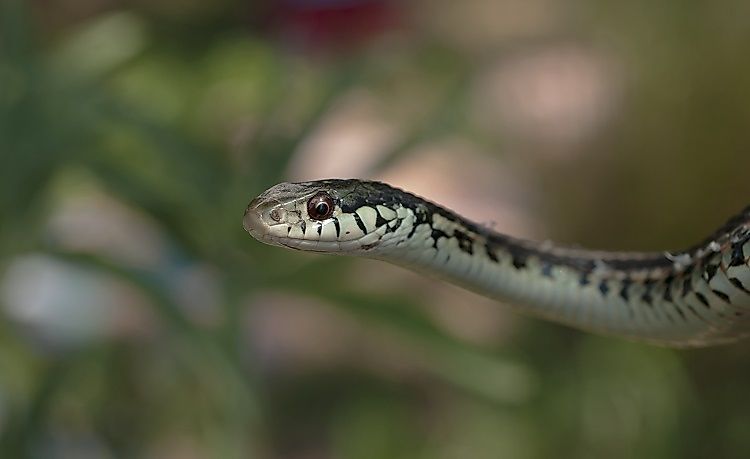Garter Snake Facts: Animals of North America

5. Physical Description
The Garter Snake, also referred to as a “gardener” snake or “garden” snake, is the common name referring to a harmless group of snakes with fairly thin bodies. These reptiles comprise the genus Thamnophis, and are endemic to Northern America. Garter Snakes come in a variety of colors depending on the species, but most of them have three longitudinal stripes that are predominantly greenish or yellowish in color. One of these stripes runs down the center of the back, with another on each of the two lower sides of the body.
4. Diet
Due to the fact that Garters nearly exclusively inhabit areas that have some form of water nearby, and that hey are carnivorous, it should come as no surprise that amphibians, earthworms, and other insects comprise such a large portion of their diet. As is the case with many snakes, their food is often swallowed whole, sans chewing. Common prey to the garter snake also include leeches, ants, frog eggs, and crickets.
3. Habitat and Range
Many varieties of Garter snake can be found throughout much of North America. Their wide distribution in this region is due to their adaptability to different habitats and diets. Their enjoyment of proximity to water varies greatly, with those in the Western regions of North America more aquatic-loving than their Eastern US counterparts. Their habitats can stretch into forests, fields, woodlands, grasslands and lawns. Garter snakes have been listed by the International Union for the Conservation of Nature's 'Red List of Threatened Species' as having ''least concern'' in terms of threat of extinction. This owes in large to the fact that these snakes have a wide habitat range and population size, which stands at approximately over a million adults. In addition, their highly-effective defense mechanisms also play a hand in the degree to which the garter snakes flourish. As garter snakes are known to be very elusive, they often coexist easily with humans, and thereby frequently escape the challenges of human encroachment into their territories, or, vice versa, their own encroachment into human spaces.
2. Behavior
These snakes communicate with each other by following one another’s trails which are “pheromone”-scented. These excreted chemical messengers play significant roles in marking territories, as well as in finding potential mates during the mating seasons. Most Garter snakes are not aggressive in nature but, if disturbed, they often coil and strike, or they may discharge a malodorous and musky-scented secretion from a special gland near the cloaca to avert harm. This is one of the primary defense mechanisms of Garter snakes that can be employed when they are ensnared by predators, namely hawks, raccoons, and crayfish. In addition, these snakes may also slither into the water to escape terrestrial predators. Being heterothermic, they regulate their body-temperatures by basking in the sun, or by occupying large communal sites during hibernation to create a collective heat source and insulation with their masses of bodies. Garters are also migratory snakes.
1. Reproduction
Garter snakes often go into “brumation” before mating, a dormant behavior wherein they stop eating for around two weeks to clear their stomachs of any foods that would rot there otherwise. They then begin mating immediately upon emerging from brumation. Males will often mate in short order with several females and, after copulation, the female will leave the mating area. Once away from the mating area, females will turn their attentions towards sourcing food as well as finding a suitable place to give birth. Interestingly, the sperm from males can remain stored within the females’ bodies for several years after copulation before they are actually fertilized. The eggs containing young ones are incubated in the lower abdomen of their mothers. Gestation is between 2 to 3 months for most garter snake species and, after being incubated within the mothers, the young ones are born live. There is a wide range in snakes born at a single time from a single mother, as there can be between 3 and 80 snakes born in a single litter. After a live birth, young Garter snakes are essentially independent immediately.











